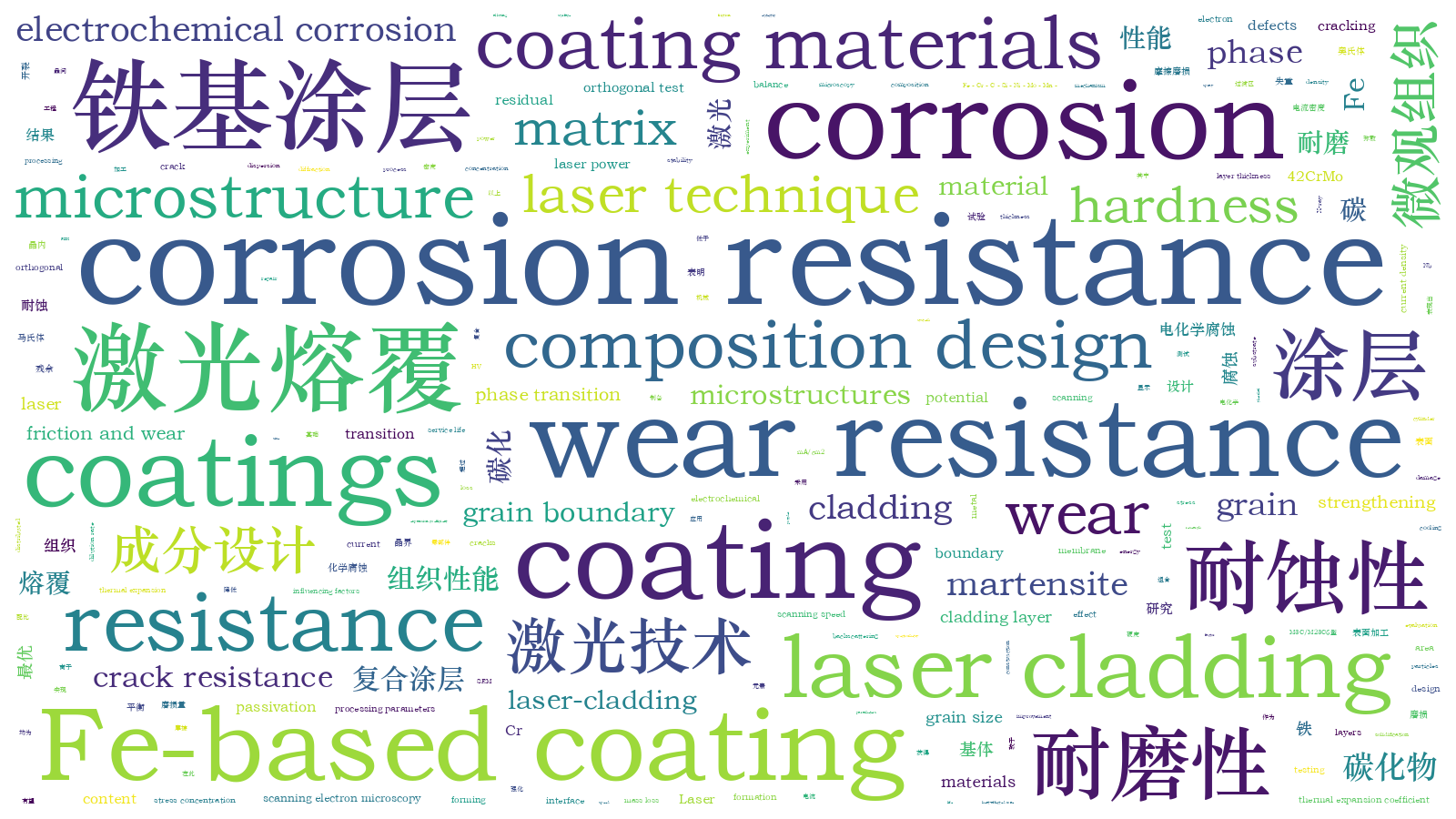激光熔覆耐磨耐蚀铁基涂层的设计与组织性能研究
To prolong the service life of the hydraulic telescopic cylinder of a roadheader, it is necessary to introduce wear- and corrosion-resistant metal coatings on its surface. Existing research shows that wear resistance requires high material hardness, which usually requires the introduction of a hard strengthening phase in the coating. However, the reinforced phase often has a certain potential difference from the metal matrix, which leads to local galvanic corrosion, thus reducing the corrosion resistance of the material. In addition, the interface area of the hard martensite matrix and hard phase lacks the necessary phase transition. Owing to the difference in the thermal expansion coefficient and interfacial defects of the hard martensite matrix and hard phase, the material is prone to crack defects during the rapid cooling of the laser cladding. Therefore, it is difficult to avoid cracking and corrosion owing to the existing high-hardness coating. Based on this, it is expected that the transition zone of residual austenite between the hard martensite matrix and the reinforced phase can be increased through composition design, which can reduce the cracking tendency of the coating. The presence of the austenite phase may also be beneficial for the improvement of corrosion resistance. In this study, four types of Fe-based cladding materials with different components were designed, and the wear and corrosion resistances of the coatings were compared. When the optimized components were determined, the mechanism of achieving a good balance between wear resistance and corrosion resistance in the coating materials was explored from the perspective of the alloying elements and microstructure.
In this study, the laser power, scanning speed, and powder feeding rate were considered as the influencing factors, while the cladding layer thickness, dilution rate, and width of the heat-affected zone were taken as the evaluation indexes to design an orthogonal laser cladding experiment. Formal laser-cladding experiments were performed on the four Fe-based coatings designed according to the optimal processing parameters obtained from the orthogonal test. The microstructures of the cladding layers were analyzed in detail using scanning electron microscopy (SEM), energy dispersive X-ray spectrometry (EDX), and electron backscattering diffraction (EBSD). The wear and corrosion resistances of the cladding layers were characterized using a friction and wear testing machine and an electrochemical workstation, respectively.
The microstructures of all four types of Fe-based coatings are characterized by martensite and carbide phases (Figs. 4, 5, and 6). The hardness of the four coatings is more than twice that of 42CrMo. The S4 coating has the highest hard carbide content and the highest hardness of 847 HV. The hardness of the S2 coating reaches 701 HV through fine-grain strengthening and dispersion strengthening of fine carbides in the grains [Fig. 7(a)]. Owing to the high hardness of the coatings, the wear mass losses of the S1, S2, and S3 coatings are more than 70% lower than that of the matrix, and the wear mass loss of the S4 coating is 86.9% lower [Fig. 7(b)]. The salt-spray corrosion test results show that the corrosion resistances of the four coatings surpass that of the substrate (Figs. 8 and 9). Further electrochemical corrosion test results show that the S2 coating has the highest corrosion potential of -0.37 V and the lowest corrosion current density of 0.017 mA/cm2 (Table 4), proving that the corrosion resistance of the S2 coating is the best.
1) The four coatings have a good forming effect without cracks or other defects, and all exhibit the microstructure form of martensite + carbide. The average grain size of the S2 coating is the smallest, and well-dispersed distributed fine carbide particles are present inside the grain, whereas the proportion of eutectic carbide in the S4 coating is the highest. 2) The hardness of the four coatings is more than twice that of the 42CrMo matrix, owing to the strengthening effect of the martensite matrix and grain-boundary carbides. The hardness of the S4 coating is the highest, followed by that of the S2 coating. The high hardness of the coating is the main factor contributing to its excellent wear resistance. 3) The corrosion resistances of S2 cladding coating is the best. The high corrosion resistance of the S2 coating is due to a few reasons. First, the coating has a relatively high Cr content; Cr can increase the steel passivation current, maintain the stability of the passivation membrane, and improve the ability of the material to repair after passivation membrane damage and other beneficial effects, which improve the corrosion resistance of steel. Second, the S2 coating has a relatively high residual austenite content in the weak corrosion area near the grain boundary, and the corrosion resistance of austenite is better than that of the matrix martensite. Third, the scarcity of strong carbide-forming elements in the alloy system reduces the formation of Cr23C6 carbide at the grain boundaries and weakens the formation of the Cr-poor zone. 4) The residual austenite located between the brittle carbide at the grain boundary and the martensite matrix in the S2 coating material alleviates the stress concentration at the interface during the solidification process and provides a potential transition, achieving a good balance of wear resistance, corrosion resistance, and crack resistance. This coating can be applied to the surfaces of various construction machinery parts.
叶界梁, 冯悦峤, 李铸国, 张训国. 激光熔覆耐磨耐蚀铁基涂层的设计与组织性能研究[J]. 中国激光, 2023, 50(12): 1202210. Jieliang Ye, Yueqiao Feng, Zhuguo Li, Xunguo Zhang. Composition Design, Microstructures and Properties of Fe‑Based Wear‑ and Corrosion‑Resistant Coatings by Laser Cladding[J]. Chinese Journal of Lasers, 2023, 50(12): 1202210.







